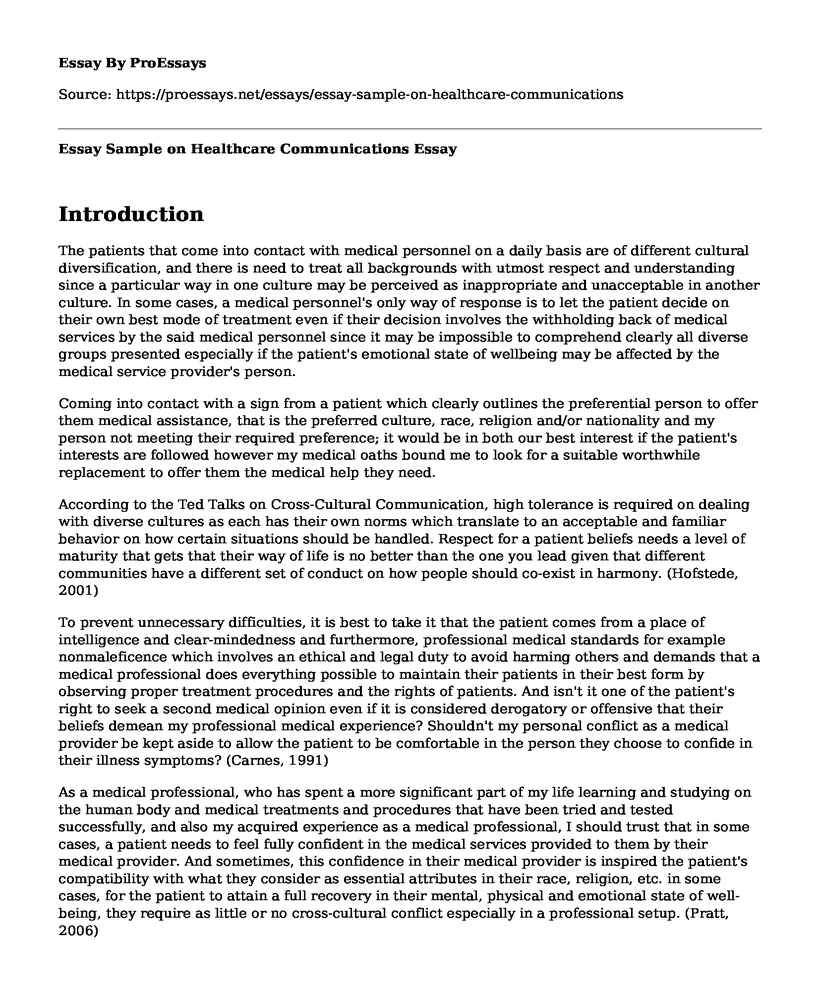Introduction
The patients that come into contact with medical personnel on a daily basis are of different cultural diversification, and there is need to treat all backgrounds with utmost respect and understanding since a particular way in one culture may be perceived as inappropriate and unacceptable in another culture. In some cases, a medical personnel's only way of response is to let the patient decide on their own best mode of treatment even if their decision involves the withholding back of medical services by the said medical personnel since it may be impossible to comprehend clearly all diverse groups presented especially if the patient's emotional state of wellbeing may be affected by the medical service provider's person.
Coming into contact with a sign from a patient which clearly outlines the preferential person to offer them medical assistance, that is the preferred culture, race, religion and/or nationality and my person not meeting their required preference; it would be in both our best interest if the patient's interests are followed however my medical oaths bound me to look for a suitable worthwhile replacement to offer them the medical help they need.
According to the Ted Talks on Cross-Cultural Communication, high tolerance is required on dealing with diverse cultures as each has their own norms which translate to an acceptable and familiar behavior on how certain situations should be handled. Respect for a patient beliefs needs a level of maturity that gets that their way of life is no better than the one you lead given that different communities have a different set of conduct on how people should co-exist in harmony. (Hofstede, 2001)
To prevent unnecessary difficulties, it is best to take it that the patient comes from a place of intelligence and clear-mindedness and furthermore, professional medical standards for example nonmaleficence which involves an ethical and legal duty to avoid harming others and demands that a medical professional does everything possible to maintain their patients in their best form by observing proper treatment procedures and the rights of patients. And isn't it one of the patient's right to seek a second medical opinion even if it is considered derogatory or offensive that their beliefs demean my professional medical experience? Shouldn't my personal conflict as a medical provider be kept aside to allow the patient to be comfortable in the person they choose to confide in their illness symptoms? (Carnes, 1991)
As a medical professional, who has spent a more significant part of my life learning and studying on the human body and medical treatments and procedures that have been tried and tested successfully, and also my acquired experience as a medical professional, I should trust that in some cases, a patient needs to feel fully confident in the medical services provided to them by their medical provider. And sometimes, this confidence in their medical provider is inspired the patient's compatibility with what they consider as essential attributes in their race, religion, etc. in some cases, for the patient to attain a full recovery in their mental, physical and emotional state of well-being, they require as little or no cross-cultural conflict especially in a professional setup. (Pratt, 2006)
Conclusion
In an evolving world, there are bound to be further divisions of deemed classes, races, religions, and caste sets of the people of the earth and almost everyone needs to trust that the medical service they get is the best. The general notion is that there is freedom of free will as long as no undue harm is caused to another by unprovoked actions of one. However, whether the focus should be on cultural segregation of medical patients and personnel based on personal beliefs is a discussion that needs to be taken seriously.
References
Hofstede, G. (2001). Culture's consequences: Comparing values, behaviors, institutions and organizations across nations. Sage publications.
Carnes, R. L. (1991). Biomedical ethics: primer and guidelines for chaplains. The Caregiver Journal, 8(4), 12-29.
Pratt, M. G., Rockmann, K. W., & Kaufmann, J. B. (2006). Constructing professional identity: The role of work and identity learning cycles in the customization of identity among medical residents. Academy of management journal, 49(2), 235-262.
https://www.youtube.com/watch?v=YMyofREc5Jk&feature=youtu.be
Cite this page
Essay Sample on Healthcare Communications. (2022, Nov 09). Retrieved from https://proessays.net/essays/essay-sample-on-healthcare-communications
If you are the original author of this essay and no longer wish to have it published on the ProEssays website, please click below to request its removal:
- Essay Sample on Generic Drug Pricing
- Evidence-Based Program: A Guide to Caring Techniques for Nurses
- Essay Sample on Volunteer Nurse Gives Back to Community: Homeless Health Education Program
- Essay Sample on Speed Limits: A Driver's Responsibility to Prevent Accidents
- Essay Sample on Elderly Security: CCTV in Care Homes
- Nursing Advocacy: An Inherent Element of Professionalism - Essay Sample
- Research Paper on Sport Medicine Career Path: An Exploration of Education, Training and Job Opportunities







